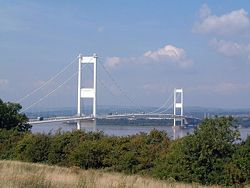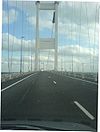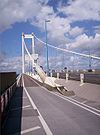Severn Bridge
| Severn Bridge Pont Hafren | |||||||||||||
| Location Map ( geo) | |||||||||||||
 | |||||||||||||
| |||||||||||||
| From: | Severn View Services | ||||||||||||
| To: | Wye Bridge | ||||||||||||
| County | |||||||||||||
| Gloucestershire | |||||||||||||
| Highway Authority | |||||||||||||
| National Highways | |||||||||||||
| Opening Date | |||||||||||||
| 1966 | |||||||||||||
| Toll | |||||||||||||
| Abolished: Removed on 19.12.18 | |||||||||||||
| Additional Information | |||||||||||||
| |||||||||||||
| On road(s) | |||||||||||||
| M48 • NCN4 | |||||||||||||
| Crossings related to the M48 | |||||||||||||
For the bridge at Bewdley with the same name, see Bewdley Bridge.
The Severn Bridge is a suspension bridge carrying road, cycle and foot traffic over the estuary of the River Severn. It was opened as a part of the M4 motorway in 1966, having cost £8M to construct, and was renumbered to the M48 when the Second Severn Crossing opened in 1996.
When built, the mile long bridge was the 7th longest in the world and 3rd in Europe. The adjacent Wye Bridge had the 5th longest span in Britain.
Cycle and foot traffic is carried via walkways separated from the main carriageway on both sides of the bridge.
Contrary to popular belief, the bridge does not form part of the border between England and Wales. What is commonly referred to as the "Severn Bridge" amounts to a combination of the bridge itself, a section of motorway over the Beachley Penninsula, and the Wye Bridge. It is the latter bridge that crosses the border.
The bridge was tolled between opening and 2018. Originally, tolls were payable in both directions, but the arrangement was later changed to avoid queuing on the bridge and after 1989 were collected only from westbound traffic. Toll charges were withdrawn on the Severn Bridge from 19 December 2018.
History
Proposals for a bridge or barrage across the River Severn – allowing traffic from Bristol to Newport to avoid a 60-mile detour via Gloucester, or the Aust Ferry which carried light traffic only – had been proposed as early as the 1920s.
The scheme which eventually emerged was a key part of the motorway plan in the 1950s and was referred to as "Motor Road 7". Construction began in 1960 and was completed by September 1966. The bridge was opened by Queen Elizabeth II on 8 September 1966 and to traffic at 07.00 on 9 September 1966 with a toll fee of 2s 6d. An estimated crowd of 75,000 were at Severnside, near Bristol and 1,000 on the Monmouthshire side for the opening. A notable image of the bridge under construction can be seen on Bob Dylan's "No Direction Home" album.
This was the first section of M4 to be opened outside West London and the Home Counties. An all-motorway journey from Chiswick to Newport did not become possible until the gap through Berkshire and Wiltshire was completed in 1971.
By the late 1980s, traffic on the two-lane bridge had become excessive, so a three-lane bridge was planned further downstream. This opened as the Second Severn Crossing, taking the M4 number from the older bridge.
When it opened, an unusual agreement with Aust services was formed whereby in the event of an incident on the bridge, a recovery truck stationed at the services would drive either along the cycle path or (if the carriageway was blocked) the wrong way up the motorway, to reach the incident as quickly as possible. If it was on the cycle path, the recovery truck would then lift the stranded vehicle over the railings.
Personnel
The bridge was constructed by a consortium of firms through Associated Bridge Builders Ltd., the same company that built the Forth Road Bridge. The firms involved were Sir William Arrol and Co. Ltd., Cleveland Bridge and Engineering Co. Ltd. and Dorman Long (Bridge and Engineering) Ltd..
The joint engineers for Ministry of Transport were Mott, Hay and Anderson of Edinburgh and Freeman, Fox and Partners of London. The latter were responsible for the design. The superstructure was built in 3.5 years and 5 months ahead of schedule.
Design
The design approach since the Tacoma Narrows suspension Bridge failure in 1940 had been to avoid the plane surfaces that the bridge had. It had been built with solid plate-web girders with a solid road deck between them and the shedding of the wind eddies from the two girders caused the road deck to oscillate. Thereafter the plate girders were replaced by open lattice girders and the solid surface of the roadway was interrupted by gaps or slots. The major eddies were thus broken up into smaller ones which had no common frequency or direction to cause rythmic oscillation.
A new approach
This involved streamlining the whole deck structure like the wing of an aircraft. This had several advantages over the trussed girder type:
- Wind drag was reduced by nearly 70%
- The full width of the box is available for use as road surface
- The exposed area of steelwork to be painted is reduced
- The box section has a much greater torsional rigidity for its weight
- Weight of the deck structure is reduced.
All the above meant that there were cost savings with the deck steelwork, cables, towers and anchorages which amounted in total to 20 to 26%.
The tests
Aerodynamic wind tunnel tests were first conducted on a simple sectional model made of timber with interchangeable edge pieces of various shapes. Vertical sides were found to be unsatisfactory but the pointed side profile, as adopted, was found to be stable for winds up to 100 m.p.h.. The best location for the footway and cycle track was found to be tight against the sharp edges of the box.
The promising results led to further tests on a scale model with accurate features. These proved the aerodynamic stability of the section apart from a slight tendency to oscillate at low wind speeds of 10 to 15 m.p.h. which with riveted or bolted trusses would normally be suppressed by the inherent structural damping. It was therefore decided to incorporate additional damping by taking advantage of the energy absorbing property of the wire rope hangers. The two parts of each hanger are separated and inclined to the vertical so that any tendency of the deck to oscillate would subject the ropes to changes in length. Such changes in length would cause the rope to absorb energy in a similar way to the axial dampers on a car.
Links
- Official page
- BBC News: Severn bridges: M4 Severn crossing reopens toll free (17.12.2018)
- Highways Magazine: Highways England takes financial hit on Severn bridges (03.01.2019)
legislation.gov.uk
- The M48 Motorway (Severn Bridge Half Marathon) (Temporary Prohibition of Traffic) Order 2019 - This Order authorises the temporary prohibition of traffic on the M48 Motorway (Severn Bridge) on the 25th August 2019 to facilitate the holding of the Severn Bridge Half Marathon.
Video
| Severn Bridge | ||
| ||
| ||
|





